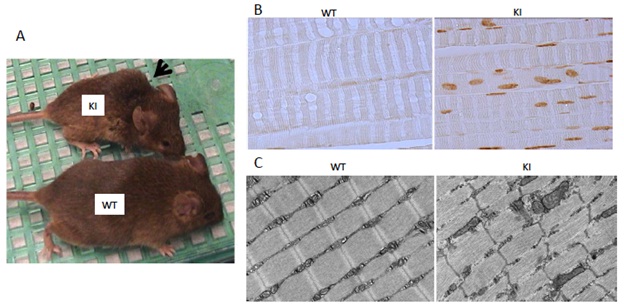Polyglutamine (polyQ) expansion causes at least nine different neurodegenerative diseases including Spinocerebellar Ataxia 17 (SCA17) that carries an expanded polyQ repeat in the TATA-box binding protein (TBP). The majority of patients with polyQ diseases carry the intermediate-length repeats (40-55 glutamines) and show the selective neurodegeneration and neurological symptoms at middle age. However, large polyQ repeats (>60) often cause juvenile cases with different symptoms than adult-onset patients. For example, in juvenile cases of SCA17 with more than 63 polyQ repeats, patients display retarded growth and muscle weakness, which are absent in adult-onset SCA17 patients. The mechanisms behind the differential pathology mediated by different polyQ repeat lengths remain unknown.
The research group led by Dr. Xiao-Jiang Li at the Institute of Genetics and Developmental Biology, Chinese Academy of Sciences, established a SCA17 knock-in (KI) mouse model with a large polyQ (105 glutamines) expansion. The KI mice displayed preferential muscle degeneration and muscle-related behavioral deficits. Direct expression of TBP with different polyQ repeats in mouse muscle via viral injection revealed that muscle degeneration is mediated only by the large polyQ repeats. By large-scale transcriptome and proteomic analysis, they demonstrated profound dysregulation of gene expression in the muscle of KI mice. To explain this muscle phenotype, they identified MyoD, a muscle specific transcription factor, whose biological functions is impaired by mutant TBP in a polyQ length dependent manner.
These findings reveal a novel mechanism of muscle degeneration caused by large polyQ repeats and explain differential pathology mediated by different lengths of polyQ repeats. Moreover, the results of this study have important therapeutic implications, as the treatment of juvenile polyQ diseases should take into account the widespread and severe pathology that may occur in peripheral tissues.
Contact:
Xiao-Jiang Li, Principal Investigator
Institute of Genetics and Developmental Biology, Chinese Academy of Sciences
Beijing, China
Phone: 86-010-64807885

Figure. Muscle pathology in SCA17 KI mice carrying 105Q in TBP. (A) Photos of wild type (WT) and TBP-105Q knock-in (KI) mice. (B) TBP immunostaining showing the accumulation of mutant TBP in muscle cells of KI mice. (C) Electron microscopy showing muscle degeneration in KI mouse muscle tissues. WT mice served as controls. (Image by IGDB)
 Figure. Muscle pathology in SCA17 KI mice carrying 105Q in TBP. (A) Photos of wild type (WT) and TBP-105Q knock-in (KI) mice. (B) TBP immunostaining showing the accumulation of mutant TBP in muscle cells of KI mice. (C) Electron microscopy showing muscle degeneration in KI mouse muscle tissues. WT mice served as controls. (Image by IGDB)
Figure. Muscle pathology in SCA17 KI mice carrying 105Q in TBP. (A) Photos of wild type (WT) and TBP-105Q knock-in (KI) mice. (B) TBP immunostaining showing the accumulation of mutant TBP in muscle cells of KI mice. (C) Electron microscopy showing muscle degeneration in KI mouse muscle tissues. WT mice served as controls. (Image by IGDB) CAS
CAS
 中文
中文




.png)
